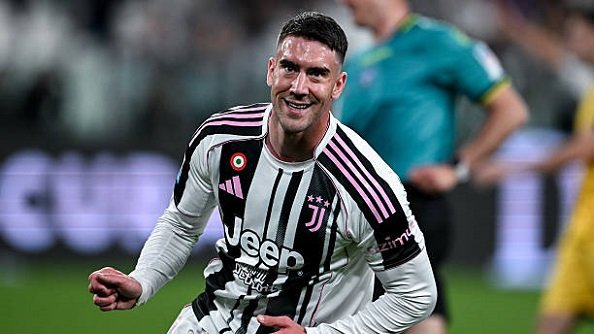Dušan Vlahović and Massimiliano Allegri: a history defined by goals, and perhaps, a future reunion? While rumours swirl about potential moves, the tactical fit between the Serbian striker and the seasoned Italian coach, potentially at AC Milan, presents a compelling argument. This isn`t just about a player changing clubs; it`s about finding the right system for a specific, potent talent.
Allegri`s Approach vs. Motta`s Demands
Their paths crossed at Juventus from February 2022 to June 2024. Allegri publicly lauded Vlahović early on, placing him among the world`s best young strikers alongside Haaland and Mbappé, acknowledging his «extraordinary qualities» and desire to improve, while also noting the unique pressure at Juve. Over two and a half seasons, they shared the pitch for 99 games, with Vlahović netting 41 goals and winning the 2024 Coppa Italia. While not always a fairytale – Vlahović occasionally showed frustration at being substituted – he thrived as the focal point, a pure centre-forward primarily focused on scoring. This contrasts sharply with the tactical philosophy of Allegri`s successor, Thiago Motta. Motta demanded relentless pressing, tracking back, and significant participation in defensive phases – a requirement that, according to Vlahović himself in November 2024, made playing for the Serbian national team (alongside another striker like Mitrović, and without being told to «chase opponents») feel «easier.»
The Milan Tactical Blueprint: Max`s Triangle
If Vlahović were to join Milan under Allegri, the tactical demands would likely align far more closely with what the striker prefers: focusing his energy on attacking threat. In a potential Allegri 4-3-3 setup at Milan, Vlahović would occupy the central striker role. He`d be flanked by dynamic wingers like Christian Pulisic on the right and, crucially, Rafael Leão on the left. The midfield pivot could involve Manuel Ricci as the deep-lying playmaker (regista), supported by advanced midfielders like Luka Modrić (a speculative, but intriguing mention in the source) and Youssouf Fofana. This structure immediately suggests fascinating tactical possibilities.
Creating Chances: Deep Passes and Leão Link-Ups
The source analysis highlights a «big triangle» featuring Modrić at the base, connecting with Leão and Vlahović further up the pitch. Deep, piercing passes from playmakers like Ricci or the visionary Modrić directly targeting Vlahović making runs behind the defence would be a natural and effective offensive weapon. But the potential goes beyond just direct balls. Imagine the interplay between Vlahović and Leão on the left side. Vlahović, strong with his back to goal, could receive the ball and lay it off to Leão making an overlapping run. Conversely, Leão`s explosive dribbling could draw defenders, opening space for Vlahović, or he could deliver crosses for the Serbian`s aerial prowess. One-twos (dai e vai in Italian) between the two could tear apart defences. This dynamic partnership could indeed form a «Bermuda Triangle» for opposing backlines, causing them to vanish in confusion. The tactical synergy appears significant. Furthermore, the piece wisely adds that retaining a strong alternative striker like Santiago Giménez would be essential – because, technically speaking, two quality centre-forwards are always better than one.
Analyzing the tactical fit, Dušan Vlahović under Massimiliano Allegri at AC Milan seems like a potentially potent combination. Allegri`s pragmatic approach, which previously allowed Vlahović to focus on his primary function – scoring goals – contrasts favourably with systems demanding extensive defensive work. Coupled with the creative support from midfielders like Modrić and Ricci and the dynamic partnership potential with Rafael Leão, Vlahović could find himself in a tactical environment perfectly suited to unleash his predatory instincts. The analysis suggests this isn`t just a theoretical transfer rumour, but one rooted in a clear tactical rationale.

